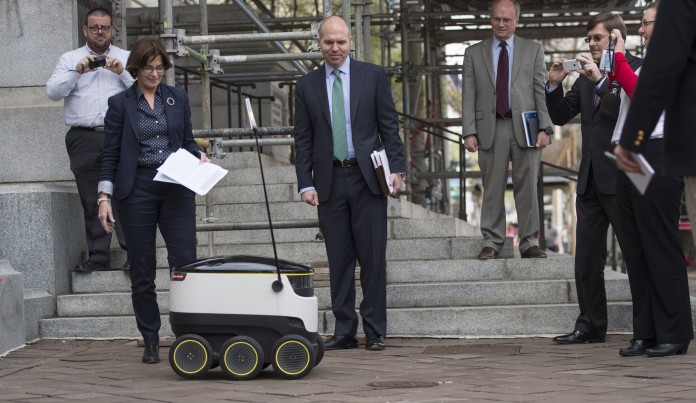
A brood of sidewalk drones could be rolling around the nation’s capital within a year, if a District of Columbia Council member has her way.
Executives from Starship Technologies, with roots in Estonia and London, say their goal is to unleash a platoon of “smart, friendly robots” that will ply sidewalks along with pedestrians to make local deliveries of groceries or small packages “almost free.” The company is led by Skype co-founders Ahti Heinla and Janus Friis, and launched the effort in November.
Councilwoman Mary Cheh and company officials sought to make a splash by promising one of the squat vehicles on Wednesday would deliver legislation to the council authorizing self-driving delivery robots. The little white device, which looks like an ice chest rolling on six wagon wheels, did indeed scoot its way into Council Secretary Nyasha Smith’s office with the three-page bill in its compartment and reporters on its tail.
But it was guided there by a young Starship employee gripping a video game controller behind his back and trying to blend into the hubbub.
“Robotic delivery!” Cheh announced.
There were no chirpy little R2-D2 sounds, just the quiet churn of bureaucracy starting to roll as Smith stamped in the legislation. “I want it to speak with me. I want it to have a relationship with me!” Cheh said.
As does Allan Martinson, Starship’s chief operating officer, who saw some 6,000 firms as a venture capitalist before deciding to join the robotic delivery startup. This is no phantom product that will have fizzled in a year, he said.
“It’s a real, tangible, solid thing,” Martinson said. “You can engineer yourself out of any situation. That’s the philosophy of this company.”
Martinson said the robots began rolling autonomously last month through parts of London and Tallinn, Estonia’s capital, using proprietary digital maps and sophisticated software. They can also be guided over the web by an operator if they get stumped on their way. To make delivery cheap — from $1 to $3 dollars a trip, hopefully dropping to under $1, company executives said — engineers are trying to keep the hardware basic. That means no laser-pulsing LIDAR, an expensive surveying technology used in many driverless car prototypes.
“It’s basically a mobile phone on wheels,” Martinson said. Its low speed and weight — 4 miles per hour and 40-pounds max — also short-circuit safety concerns, he added. “It’s basically a rolling suitcase. If you go home and try to kill yourself with a suitcase, you’d have to be very inventive.”
Cheh, D-Ward 3, also authored the city’s autonomous vehicle legislation, which took effect in 2013 and allows driverless cars on city roads as long as a human is present and can take the controls. But other than when they cross the street, the delivery robots are designed to remain off the road.
There would be many advantages, Cheh said.
Foiling package pilferers is one. Using an app, “you can tell the little robot to come deliver your package now. You can ensure it’s not just sitting around on your porch for thieves to take.”
Powered by electricity – the company says they “consume less energy than most light bulbs” – there are also environmental upsides, said Cheh, who chairs the D.C. Council’s transportation and environment committee. The robots would head out from distribution centers and make deliveries within 30 minutes, executives said.
“It’s not trucks traveling into neighborhoods,” Cheh said.
She wasn’t sure legislation was even needed. But after Starship executives approached her about having Washington center-stage in a pilot, she decided to draft a bill to be sure.
The bill caps the machines’ speed at 10 miles per hour, and weight at 50 pounds, excluding cargo, and prevents them from rolling in the central business district, similar to how bike-riders aren’t allowed on sidewalks in some places, Cheh said.
In Washington in an age of terrorism, additional restrictions could be added as the bill gets a hearing in coming months, Cheh said.
One possibility would be banning them from going in and around sensitive sites, such as Capitol Hill or the White House.
“That’s something to think about. But why is that different if it’s a robot, rather than someone walking down the street with a backpack?” Cheh asked.
And to her, ground drones have fewer security implications than flying ones, which have been touted as a potential delivery breakthrough. There are some concerns an airborne delivery could potentially “go over the White House fence,” she said. But “this would stop at the fence. It seems so much more benign and easy to control.”
As for run-of-the-mill thieves and vandals, Martinson said he’s not worried. A hitchhiking robot was destroyed in Philadelphia last year, bumming out the Canadian researchers who built it. But Starship’s machines have 9 cameras, stream live video back to their base, and can easily call for police, or other, backup, Martinson said.
“We can send other robots in the area. They would come to help the robot in distress,” Martinson said.
So far, the instincts among the tens of thousands of people who have encountered the robots have not tended toward the destructive, he said. One person tried to feed it a banana.
Somewhat disappointingly, most people — more than 80 percent, company engineers have found — simply ignore them. No pictures, no nothing. “We were even insulted a little bit,” Martinson said.
Company executives say they plan to sell their delivery services to other businesses, and they are in discussions with some of them. They will charge a combination of monthly as well as per-mile or per-trip fees, Martinson said.
Three to six months of testing will begin in the southern United States and West Coast in April or May, Martinson said, with a couple robots in each city. He expects three to four weeks of testing in the District and elsewhere. Some pilot deliveries are possible in that period, but they expect to reach commercial scale next year, he said. The final three to five U.S. launch cities have yet to be chosen, and that will largely depend on where their business customers want to go first, Martinson said.
Cheh said the business model is up to them to figure out. But she’s ready.
“It’s so cutting edge, it’s so innovative, it’s so cute. People might want to have their books or whatever else delivered by the robot,” Cheh said. “I would.”
Chris McGraw, a District resident visiting the Wilson Building on Wednesday, happened across the robot (and its remote controller) returning from delivering cupcakes to offices of council members.
“I know they’re smart guys. . .I wish them success,” McGraw said. Still, “I hope it stands up to D.C. city streets. The wheels look a little flimsy to me.”
(c) 2016, The Washington Post · Michael Laris / Washing Post photo by Nikki Kahn
{Matzav.com}











